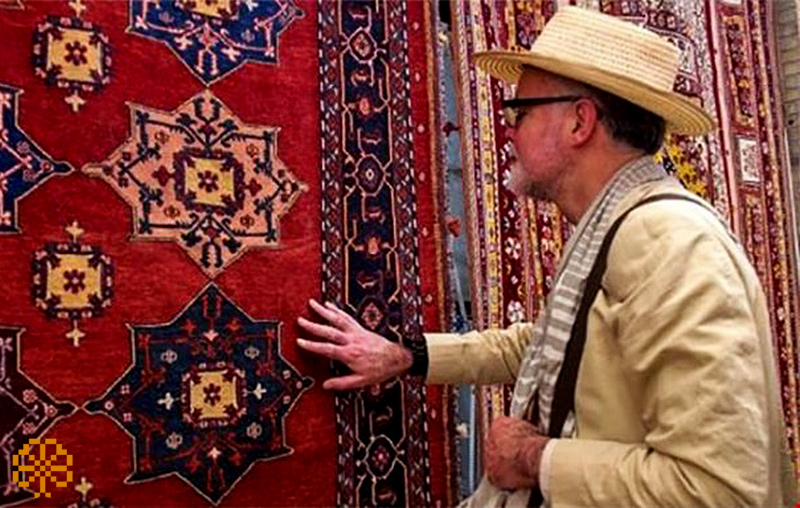Export of Iranian handmade carpets and shocking statistics from it!

The export of handmade carpets can definitely be introduced as one of the main non-oil exports of Iran to the world, which in recent years has faced a sharp and unbelievable decline, which has led to a special downturn in the carpet weaving industry.
In this article from Farahan Carpet, we intend to examine all the statistics and problems of exporting handmade carpets in detail, and then, by introducing the necessary conditions and documents for this, we will help you to enter with sufficient information if you intend to export carpets. Be it.
Export of handmade carpets in 1400
To start the discussion on the export of handmade carpets, we go to the statistics published according to the Iranian customs statistics to compare the situation of the export situation in the carpet weaving industry in recent years with a little comparison.
According to statistics, the highest export of Iranian carpets occurred in 1994. This year, Iran was able to set a staggering statistic by recording a record $ 2.132 billion in exports of handmade carpets to other parts of the world.
The value of this statistic becomes even clearer when you realize that this year, nearly 44% of Iran’s total non-oil exports have happened only with carpets and has created about 5 to 7 million new jobs.
It was around 1973 that Iran began its downward trend in the international arena in the field of carpet exports; Only a year later, in 1974, exports fell from $ 2 billion to $ 1 billion, and in 1975 that number rose to $ 675 million.
This downward trend has continued so long that if you hear its rate in 1400 you may not believe it. The amount of Iranian hand-woven carpet exports last year was only $ 50 million !! Make a simple comparison with the year 73, that is, 2134 with 50 !!!
Read more: Malayer handmade carpet | Check specifications + shopping guide
10 reasons for the decline in Iranian carpet exports
After reviewing the statistics that we mentioned in the previous section, perhaps the question is ready for you in advance, what were the reasons for this decline in the export of Iranian handmade carpets ?? There have been many obstacles and problems that have caused this to happen, and we will introduce the most important ones to you in the following:
1. Loss of high sales volume in European and American markets with the imposition of sanctions against Iran; It is interesting to know that before the sanctions, 25% of Iranian hand-woven carpet exports were only to the United States.
2. Supply of low quality and cheap carpets from China and India as Iranian handmade carpets.
3. Removal of the National Carpet Center from the new structure of the Ministry of Industry, Mines and Trade (Samat), which reduced the officials’ attention to the carpet industry.
4. Severe problems in money transfer and presence in international markets in recent years.
5. Improper foreign exchange commitment policy that has bored domestic traders for exports. In a foreign exchange commitment, carpet traders are obliged to deliver the currency from the carpet that they have not yet sold in the manner determined by the Central Bank.
6. Reluctance of domestic traders to export carpets. If the traders fail to fulfill the foreign exchange obligation mentioned in the previous section, their business card will be canceled. As a result, this policy has led many traders to stop exporting Iranian carpets and rugs.
7. Rising raw materials and the cost of hand-woven carpet weaving, which has reduced the production of this valuable Iranian art.
8. Existence of problems and strange customs laws of Iran. It is interesting to know that according to 121 Iranian Customs Administration, it is not possible to return carpets that need to be repaired or that have been stored in the foreign market!
9. Lack of global market evaluation and expert work. With the development and expansion of global markets, it is no longer possible to work in the traditional way, and it is an important need for experts to study the culture, demand and tastes of different countries to be able to write a targeted program for the production of Iranian carpets. An issue for which no action has been taken so far.
10. The expansion of production and variety of machine-made carpets and the entry of new floor coverings into the market, has inadvertently caused a slight decrease in the market and exports of handmade carpets.
These are just some of the main reasons for the decline in exports of Iranian hand-woven carpets in recent years, which has caused us to face a 50-fold drop in exports instead of 73 in 1400 compared to 73.
With this situation, should we stop exporting carpets?
Perhaps after the above, the question is ready for you whether someone who intends to export handmade carpets should give up? The answer to this question is definitely no.
It is interesting to know that with all these problems and the decline in exports that Iran has had in the carpet industry, it is still among the top 3 carpet exporting countries in the world. According to global statistics, the share of the Islamic Republic of Iran’s exports in carpet exports is 7.9 percent, of which only India with 31.7 percent and Egypt with 18.2 percent are higher than Iran, and Iran is in third place.
In the global markets, Iranian carpet is still one of the highest quality and most popular options for purchase, which with a little support and attention we can return to our original position.
Countries such as Latin America, China and Russia are the largest markets for Iranian carpets, and among European countries, Germany, the United Kingdom and Switzerland also welcome Iranian carpets. However, we should not forget the Arab countries such as Lebanon, Kuwait, Qatar and the UAE, which have a lot of respect for Iranian carpets.
So it is true that the current sanctions on Iran have made it difficult to export handmade carpets, but there are still very large markets in the world that can be used for export.
Handmade carpet export guide
We said that we need to be able to identify suitable markets for the export of hand-woven carpets and to be able to export carpets in a specialized way according to the tastes of the people of that country so that we can compete with the carpets of other countries in the best possible way.
That’s why we have compiled a list of your favorite carpet colors from different countries so that you can export them accordingly.
Germany: The German people are mostly looking for carpets with soft colors, navy blue and lacquer that have a maximum of 6 square meters.
USA: The American market mostly prefers carpets in chocolate, light brown, gold, ivory, pea, gray, silver, cream, and generally light colors, and is more looking for small sizes such as 2.3 meters and In some cases, they are 3.4 meters.
England: In terms of color, the British people are fashionable and are very close to the American people in terms of taste.
UAE: The people of this country like bright and cheerful colors, especially cream and all reddish colors, especially lacquer of Mashhad and navy blue. But in terms of area, they are both looking to buy small areas for their homes and very large areas for religious places.
Switzerland: Swiss people mostly enjoy dead, soft and soft colors, especially old natural colors such as onion skin, cream and blue, and they do not buy carpets longer than 6 meters at all.
In this article, we have tried to thoroughly review everything you need to know about the export of Iranian handmade carpets, but if you would like to know more about the export of carpets to other parts of the world and their tastes, leave it in the comments section for Write us to prepare it for you in more detail.






